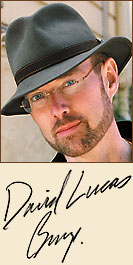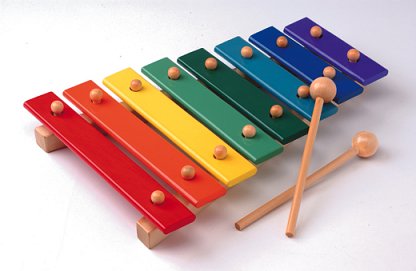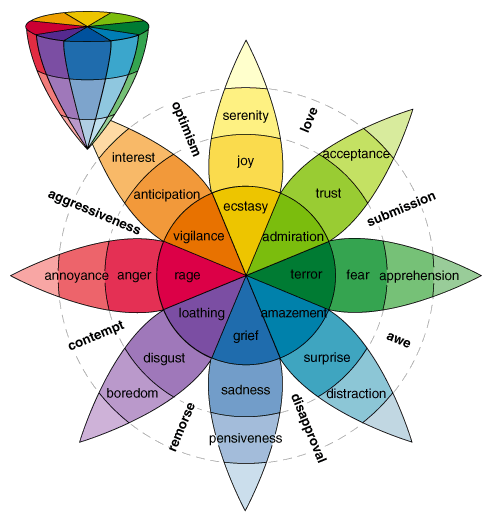http://perfectpitchtest.com/
How did you do? It is not easy I can tell you unless you have some built in reference point like Middle C. If you are clever, maybe you can remember a song in a certain key and use that to give you some sense of pitch. Anyway, here is the guy I saw in that guitar magazine from the early 1990's.

His Perfect Pitch Pitch course can be purchacsed here in case you ever want to invest in something like this:
http://www.perfectpitch.com/chapter1.htm
Somewhere in the article it discussed the concept of a color to pitch relationship. My first thought was WOW! That is cool. I immediately went to the library and BINGO found a historical perspective on the idea. From Aristotle to the modern day it seemed like everyone knew about this idea but me. Then I remembered how children seem to be given this concept rather early in life but never are told the reasons why music is not learned this way. Do you remember your first xylophone?

That's right it's in color. The problem is that this connection is lost by the time you get your first music book. All we ever see by the age of 10 is black and white notation. This is by far the worst way to identify different degrees of pitch. No wonder we struggle to play music. If playing guitar is not hard enough we also have to overcome a low-grade application of human emotion to the wriiten musical note. Did you know our emotions can be "assigned" a certain color?

http://www.fractal.org/Bewustzijns-Best ... otions.htm
With me so far? I mean this is damn cool if you can actually "see" why certain songs make you feel one way or another. All you have to do is learn the language and you may even become a better musician. You could explain why you choose certain notes in a song verses just saying it "felt" right. Once you are aware of the colors of emotion you need to know exactly why a certain pitch can have only one color associated with it. In an octave of a Major Scale in the Equal Temperament System there are only 8 notes (12 if you count all the semitones). Each one has a frequency assigned to it. A=440 Hz wasn't adopted until 1936 by the American Standards Association. If you ever turn on a tuner it is calibrated specifically to A=440 Hz.
In order for anyone to believe this relationship actually exists you need to use a little math. Just as there are many octaves on a keybord there are many octaves of vibration we cannot see or hear. Dogs hear sounds that the human ear just can't perceive. Blow a dog whistle and just watch how many dogs will respond to it. Take Middle C on the keyboard for example. Every time you jump to the next octave above it you have just "doubled" the frequecy of that note. For example: A=440Hz x 2 = 880Hz. What if you want to land somewhere in the light spectrum? Those frequencies are pretty large so you will need to multipy Middle C (261 Hz) by at least 40 octaves. The primary similarity between light and sound are their behavior as waves. There is a mathematical equation which can calculate all the frequencies we need. We use this: wavelength = velocity / frequency. Our chart of frequencies then end up like this...
F ------- 349.228231 Hz ~ 780.749171 nm
F#/Gb -- 369.994423 Hz ~ 736.929087 nm
G ------- 391.995436 Hz ~ 695.568436 nm
G#/Ab -- 415.304698 Hz ~ 656.529179 nm
A ------- 440.000000 Hz ~ 619.681028 nm
A#/Bb -- 466.163762 Hz ~ 584.901004 nm
B ------- 493.883301 Hz ~ 552.073033 nm
C ------- 523.251131 Hz ~ 521.087555 nm
C#/Db -- 554.365262 Hz ~ 491.841158 nm
D ------- 587.329536 Hz ~ 464.236235 nm
D#/Eb -- 622.253967 Hz ~ 438.180657 nm
E ------- 659.255114 Hz ~ 413.587466 nm
F ------- 698.456463 Hz ~ 390.374586 nm
Here's our piano keyboard (colored) based upon these calculated pitches.

Now you are ready to be musical painter, but first you need to know the rules of painting. The Color Wheel is used to find the colors which best combine together. There are 3 possible ways of combining colors. There are the Primary Colors, Secondary Colors, and Tertiary Colors. While I won't explain how to apply these different ways I'll give you a head start on what it would look like if you applied these theories together. The rest is up to you...